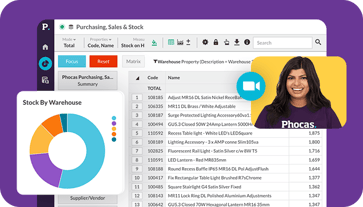How to improve your business budgeting processes
It’s no secret that completing the annual budget is a headache for CFOs.
The entire process is extensive and time-consuming. Traditional budgeting tools make sharing between team members complex and cumbersome. Transferring information between Excel spreadsheets and teams leads to unavoidable errors. Frankly, you can spend a lot of time putting together a document that may not even be useful in the end.
Fortunately, there are better ways to budget and build collaboration into the process. It starts with a single source of truth where team members can pull in the previous year’s data such as cashflow, expenditures and income statements. Having access to common, relevant data ensures the finance team is working with the correct information and streamlines discussions as they share with other contributors. This makes modelling and comparing scenarios easy to repeat as part of your decision making.
Techniques that improve the budgeting process
Collaborative budgeting may not look like the traditional process you currently use, and it may take some trial and error to learn how to make it work. The following techniques can help improve the process:
- Driver-based budgeting: Your detailed data gives you deeper views into what’s happening within the company, leading to more effective driver based budgets that are easier to execute and monitor. Use it.
- Side-by-side comparisons: Stop emailing spreadsheets back and forth between teams. A robust platform makes it possible to share information in real-time for more streamlined planning processes.
- Rolling budgets: A rolling budget may be more responsive to your business needs, allowing you to adjust the budget as needed in response to trends and external factors .
- Protecting data: Not every team member needs to see every line item. Help them stay focused by hiding sensitive data like remuneration and bonuses from select team members.
Tips for building collaborative FP&A into budgeting
No single budget approach works for everyone, as they all have their own pros and cons. Whether you choose a date- or zero-based budget is a matter of preference. It’s more important that you have access to the information you need, such as fixed costs and EBITDA from previous years. Here are more tips to help you toward the goal of collaborative budgeting.
Update your budget as needed
Budget understatement happens. That’s just one reason to consider revisiting and updating your budget more than once a year and comparing it to your forecast. Revising your budget throughout the year helps the budget work for you instead of forcing you to work for the budget.
Keep two budgets
Consider keeping two budgets: aspirational and baseline. This can be especially useful when you have budget deviations in a given year. Use the aspirational budget to reflect what you’d like to see happen in the coming year and the baseline budget as a guide.
Allow for change
You need up-to-date information for effective budgeting. Negative market trends will likely mean you need to continually revisit your budget and re-forecast. Having the ability to compare budgets based on live data from your accounting software against fiscal years will help with your budget planning.
To find out more about building collaborative FP&A into budgeting, download this ebook, Modern Financial Planning and Reporting.

Sonya specialises in developing FPA and xPA conferences and webinars for finance professionals.
Related blog posts
If you’re nodding along to this headline, you’re probably interested in finding out how this process can be made reliable and repeatable. Many finance teams need spreadsheets, email trails and offline files to make critical adjustments before reports are ready for the business. It works until it doesn’t. As complexity grows, the gap between your ERP and the final ‘true’ management view widens.
Read more
Asahi Group (a large beverage manufacturer and distributor) recently experienced a cyberattack that didn’t destroy the business, but did create the kind of operational and financial mess most mid-market companies recognize. Orders couldn’t be processed normally, shipments were delayed, call centres were disrupted and some products became temporarily hard to get in retail and hospitality channels. The impact showed up quickly in results. Domestic sales dropped materially for a period while systems were restored and workarounds were put in place.
Read more
Intercompany journals are like transferring stock between two warehouses in the same distribution group. One warehouse records inventory going out at as an internal transfer price, and the other records it coming in. The group hasn’t gained or lost anything — it’s just tracking the internal movement.
Read more
Finance departments in mid-market companies are planning more. Why? Because the market is volatile and competitive, and to stay profitable and keep customers coming back, business planning has become mandatory.
Read moreBrowse by category

Find out how our platform gives you the visibility you need to get more done.
Get your demo today